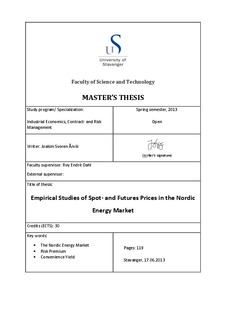| dc.description.abstract | The Nordic Energy Market is introduced and its characterizations discussed. Descriptive analysis of spot- and futures prices has been performed and the results have further been used in order to uncover forecast errors, basis risk and seasonal trends. Additionally the N02 area price has been compared to the unconstrained system price, aiming to explore the potential of cross hedging through short-term futures contracts.
The relationship between spot prices and short-term futures contracts showed forecast errors of 2,1%, 9,2% and 11,6%, respectively for weekly contracts in one-, four-, and six- week holding periods throughout the period 2007-2012. Nevertheless, the futures price is found to be the best estimate for the future spot price in a one-week horizon, but the six-week prediction was improved by including additional historical price information.
It is found likely that the forecast errors are a result of a net-long demand from consumers, creating negative risk premiums. Unique market- and commodity characterizations provide asymmetric flexibility between producers and consumers. Further, we find the electricity price to be extremely volatile with annualized weekly changes of 110% and with frequent values far beyond this. Combined with positive skewness, these price properties could contribute to amplify the imbalance in the market. A pitfall was uncovered when the forecast errors were interpreted as risk premiums. There was an unexpected deviation between the results from the forecast error equation and results from the equation of the Theory of Risk Premium. This must be taken into account when comparing different studies on this topic.
Due to hydro dominance in the market, the Theory of Storage was successfully interpreted to the empirical results. We found the market to exhibit Contango, showing negative net-convenience yield, throughout most of the year. However, the size of the risk premium was not found to be dependent of the futures curve, nevertheless increasing with rising price level.
At last, we found the N02 area price to be almost exclusively below the system price. This could give producers in such areas incentives to take short-positions in futures contracts. Simple cross hedging methods gave variance reduction of around 50%, but the basis risk was still substantial. However, both the skewness and the extreme values indicate that the upside of spot exposure is minimal. Hence, the risk of lost upside through hedging is negligible. | no_NO |
